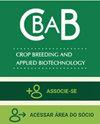巴西植物育种:过去50年的回顾
IF 1.1
4区 农林科学
Q2 Agricultural and Biological Sciences
引用次数: 7
摘要
摘要:近50年来,植物育种在巴西农业中的重要性不断提高。这主要是因为:研究生项目的增加,使数百名专业人员获得了资格;创建EMBRAPA和其他研究机构或国有公司,重点生产新品种;颁布了品种保护法,刺激了对种子生产的投资。这项工作的重点是回顾所发生的事情,使该国从谷物、水果和纤维的进口国转变为全球最大的这些产品出口国之一。本文以一些农产品为参考,着重介绍了近年来植物育种的重大贡献。此外,一些仍然需要克服的巨大挑战,巴西饲养员的参与将是未来几年农业继续进步的根本。本文章由计算机程序翻译,如有差异,请以英文原文为准。
Plant breeding in Brazil: Retrospective of the past 50 years
Abstract: The importance of plant breeding in Brazilian agriculture has grown a lot in the last 50 years. This occurred mainly because of the: increase in graduate programs, which qualified hundreds of professionals; creation of EMBRAPA and other research institutes or state companies, with an emphasis on the production of new cultivars and; promulgation of the cultivar protection law, which stimulates investments in seed production. The retrospective of what happened, enabling the country to move from being an importer of grains, fruits, and fibers to one of the largest exporters of these products worldwide, was the focus of this work. Taking as reference some agricultural products, this article highlights the significant contribution of plant breeding in recent years. Also, some of the enormous challenges that still have to be overcome, in which the participation of Brazilian breeders will be fundamental to continue the progress of agriculture in the coming years.
求助全文
通过发布文献求助,成功后即可免费获取论文全文。
去求助
来源期刊
CiteScore
2.40
自引率
13.30%
发文量
25
审稿时长
6-12 weeks
期刊介绍:
The CBAB – CROP BREEDING AND APPLIED BIOTECHNOLOGY (ISSN 1984-7033) – is the official quarterly journal of the Brazilian Society of Plant Breeding, abbreviated CROP BREED APPL BIOTECHNOL.
It publishes original scientific articles, which contribute to the scientific and technological development of plant breeding and agriculture. Articles should be to do with basic and applied research on improvement of perennial and annual plants, within the fields of genetics, conservation of germplasm, biotechnology, genomics, cytogenetics, experimental statistics, seeds, food quality, biotic and abiotic stress, and correlated areas. The article must be unpublished. Simultaneous submitting to another periodical is ruled out. Authors are held solely responsible for the opinions and ideas expressed, which do not necessarily reflect the view of the Editorial board. However, the Editorial board reserves the right to suggest or ask for any modifications required. The journal adopts the Ithenticate software for identification of plagiarism. Complete or partial reproduction of articles is permitted, provided the source is cited. All content of the journal, except where identified, is licensed under a Creative Commons attribution-type BY. All articles are published free of charge. This is an open access journal.

 求助内容:
求助内容: 应助结果提醒方式:
应助结果提醒方式:


